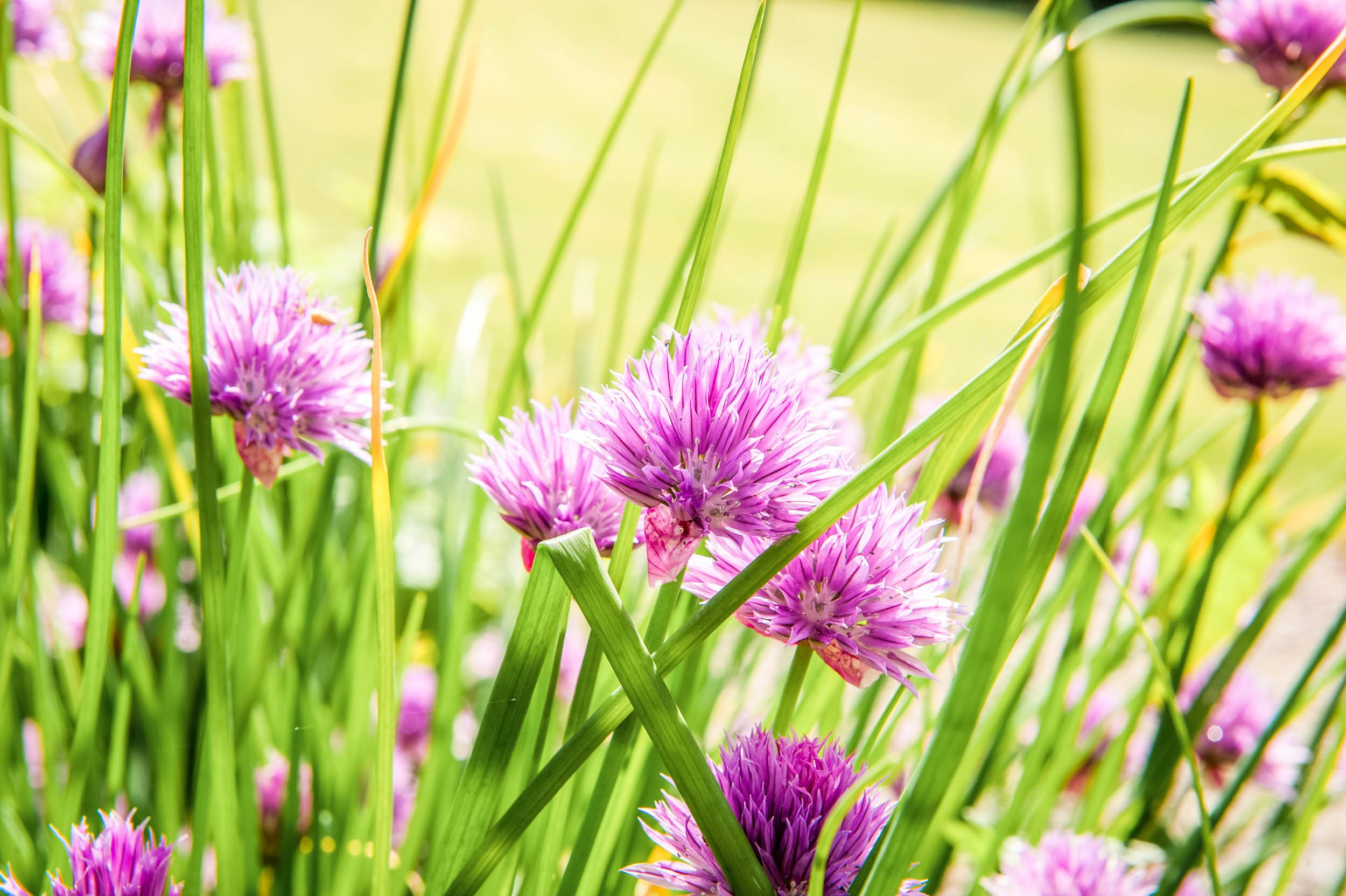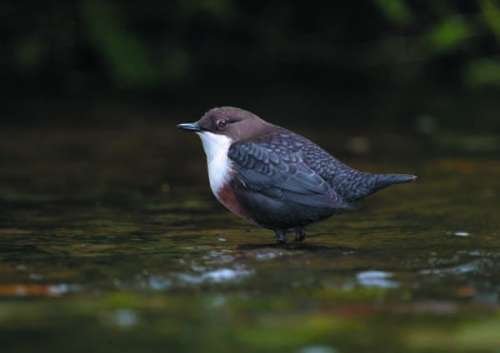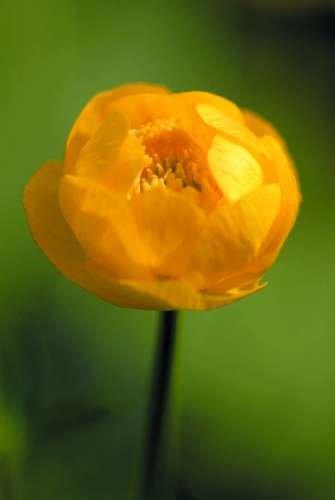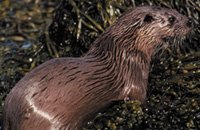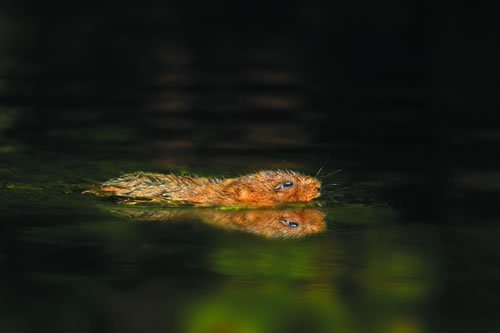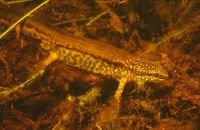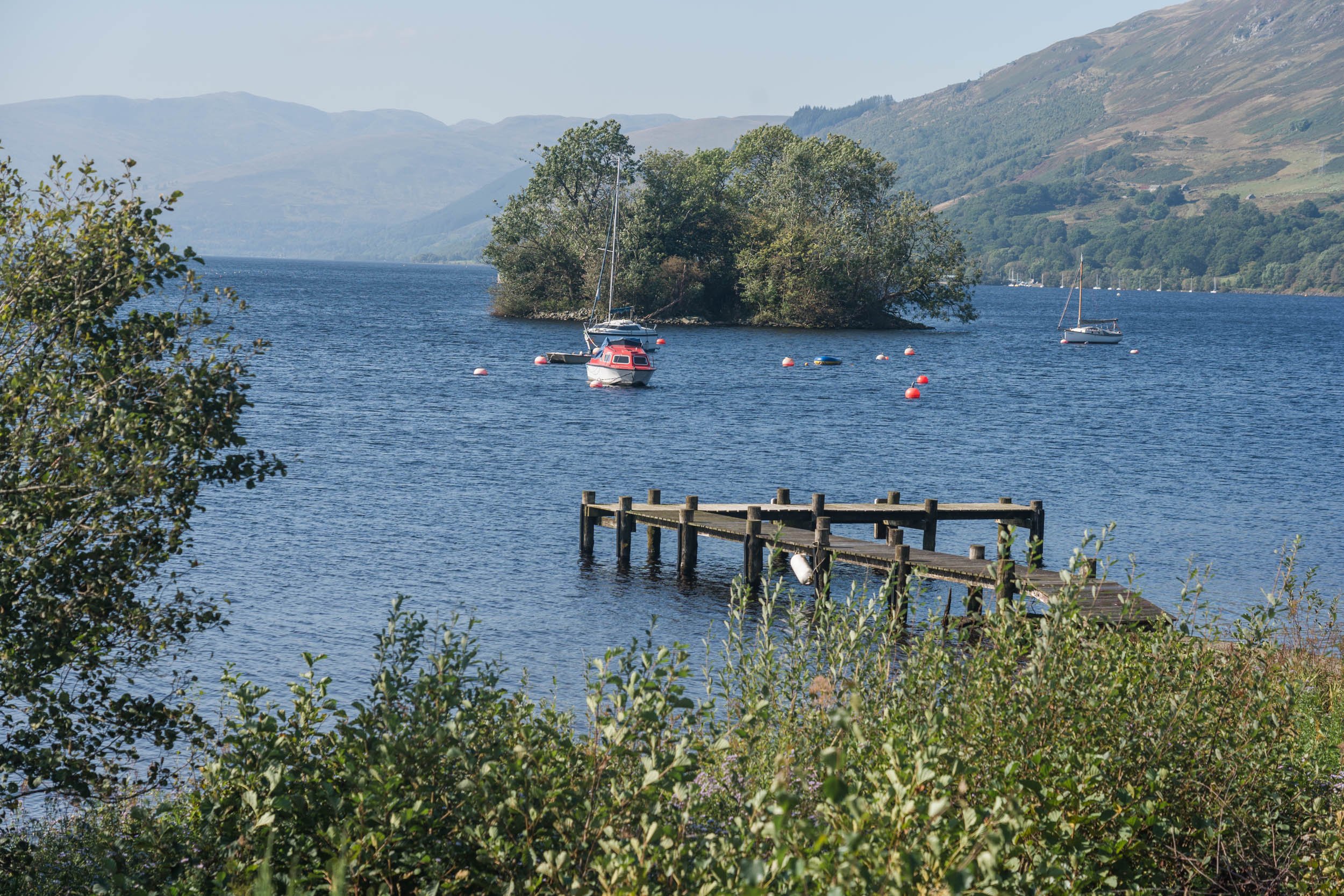
Freshwater & Wetlands
(Picture: Loch Earn)
Nature in Loch Lomond & The Trossachs
Loch Lomond is the biggest area of fresh water in the Park, and indeed in the whole of Britain, but there are 22 sizeable lochs in all, along with around 50 rivers, so wherever you choose to go in the Park you will probably find yourself close to water. The lochs are mostly quite poor in nutrients, which means that they can support some special wildlife that can’t survive in more nutrient-rich water. The rivers often start as boulder-strewn, tumbling burns high in the hills, slowing and softening as they reach the lowlands.
All this water is also essential to maintain the wetland habitats - marshes, bogs, fens, mudflats – that provide a home and food for so much of our wildlife. White-fronted geese travel all the way from Greenland to feed on the marshland at the foot of Loch Lomond, otter and water vole find refuge, dippers love the fast-flowing streams, while salmon and trout return each year to spawn in the headwaters of our rivers.
The list below will tell you about some of the wildlife to be found in the Park’s freshwater and wetlands. There are also links to other websites where you can find out more.
-
Latin name: Cinclus cinclusDipper
Size: Length 18cm
Where: Upland streams and rocky rivers, for example around Loch Earn, Glen Finglas and Glen Falloch
When: All year round
Walk by any tumbling burn or boulder-strewn river in the National Park and you are likely to see a dipper – or at least catch a flash of its spray-white bib as it zips upstream on its stubby, sooty-black wings. Between a robin and a blackbird in size, these jaunty little birds are completely at home in the torrents. They often make their dome-shaped nests behind waterfalls or weirs, forcing their chicks to brave the pounding water to make their first flights.
Few birds are as well named as the dipper. You will see them bobbing on the rocks in mid-stream like curtseying Victorian housemaids. Stay and watch and you may be rewarded by the sight of one walking straight down into the water to feed on the river bed, hunting for a juicy caddis fly larva or water snail.
Find out more at:
-
Latin name: Salmo trutta
Weight: Most are 500g - 1kg, though they can grow to 20kg
Where: Fast flowing, well-oxygenated streams and rivers
When: Evenings, when insects are flying over the water
Though the trout is one of our favourite game fish it is actually a powerful predator itself – a water leopard with the spots and sharp teeth to prove it. Young trout feed on small invertebrates, but as they grow they will start to prey on other fish, and the biggest will even take small birds and mammals that venture into the water.
Look out for them in fast moving streams and rivers, heads pointing into the current as their powerful bodies hold them in place. People used to think there were two distinct species – brown trout and sea trout. But we now know they are actually just different strains of the same species that have found different ways of surviving. Sea trout follow a salmon-like existence, migrating to the Altantic to feed for a number of years before returning to the rivers where they were born to breed. They tend to be greyer than the aptly named brown trout, which stay put in their home rivers for the whole of their existence.
-
Smooth newt Latin name: Triturus vulgarispalmate newt
Length: Up to 10cm
Palmate newt (pictured) Latin name: Triturus helveticus
Length: Up to 8cm
Where: Ponds and other wet places
When: Spring and summer
Newts are the nearest thing we get to dragons – albeit miniature ones. With their fiery orange bellies and long, wavy crests the males look particularly fearsome in the breeding season. They are indeed fierce predators, lurking in the pond weeds ready to pounce on unwary tadpoles – a favourite prey. Despite this they are diligent parents. The female wraps each of her eggs up individually in a leaf of pond weed to keep it safe until it hatches into a newt tadpole.
Palmate and smooth newts are the more common of the three species you can find in the UK. The third is the much rarer great crested newt. Look for them under logs or rocks by ponds and wet flushes, where they hide from their own predators outside the breeding season.
The two species aren’t that easy to tell apart. Palmate newts are smaller – the smallest amphibian in the UK – but this can be hard to gauge unless you see them side by side. Smooth newts have spots on their creamy yellow throats, while palmates are spotless. And palmate newts, as their name suggests, have large webbed feet like palms, especially in the breeding season.They use these to help them to hold on to their mates! Palmate newts also prefer more acid conditions, and softer water, so you are more likely to find them on moorland and bogs.
-
Latin name: Rumex aquaticus
Height: Up to 200cm
Where: Crom Mhin – east Loch Lomond side
When: Late June and early July for flowers
This is the National Park’s very own plant – it grows nowhere else in Britain. It is found in a few marshy places at the south east end of Loch Lomond. Despite its size it can be difficult to pick out if you are not an expert, though its long, slender leaves set it apart from many other docks and sorrels.
It blooms in early summer, its delicate greeny-cream flowers hanging in bunches from the axes of the leaves. By late summer these have turned into tiny, nut-brown seeds.
-
Latin name: Trollius europeaeus
Height: 20-40cm
Where: Upland wet meadows and stream sides
When: Flowers May to July
Bigger and bolder than most buttercups, globeflowers bring sunshine to grey summer days. Their big, bright yellow spheres shine out by upland streams, on dripping, grey cliffs and in damp woodlands.
Despite their beauty an old Scottish name for them is witches’ gowan – maybe because like all the buttercup family they are poisonous.
-
Latin name: Arvicola terrestrisWtar vole
Size: Body length 12 - 20cm
When: All year round; when it’s very quiet
Where: Loch Ard Forest
A long, V-shaped wake, a sudden plop or the rustle of the bankside grasses are often the only signs you will see of a water vole. They are nervous, secretive creatures – and for good reason. Their numbers have plummeted by 90% over the last few decades. A combination of changes in farming practices and flood control has led to massive habitat loss. On top of that mink, an alien species that escaped from fur farms in the 1960s, have become a major predator.
There are still water voles in the river banks and lochs of the National Park. Some have even been found in tiny lochans in the hills north of Glen Dochart! They are excellent swimmers, though they mainly feed on grasses and other bankside plants. A good sign of their presence is small pieces of nibbled grass left in little piles by the river – they tend to be messy eaters.
If you do catch sight of a water vole sitting on a bank you will understand why they were the inspiration for Kenneth Grahame’s Ratty in Wind in the Willows. They sit on their haunches, their fat little bodies and rounded faces making them appear almost human.
-
Latin name: Esox lucius
Length: Males: 25 - 100cm; females: Up to150cm
Where: Slow moving rivers and lochs, for example Loch Lomond and Loch Venachar
When: All year round – easier to spot in spring and summer
Next time you cross a bridge over a slow moving, weedy river, look carefully into the water – there may be a monster lurking there. See its huge head, its rows of sharp teeth, the green-grey shimmer of its powerful, muscled back. It’s a pike.
Pike are our freshwater sharks, hiding among the reeds ready to launch out at unwary prey. They aren’t fussy eaters – fish, frogs, ducklings are all fair game. Pike can grow to truly monstrous proportions. A fish caught in Loch Lomond in 1947 weighed 47lb 11oz (21.6kg). Despite their size they are not easy to spot because of their habit of hiding in the water weeds. You need a warm, dry, still day when the water is clear, and the patience to wait and watch.
-
Latin name: Rana temporariacommon
Length: 6 – 10cm
Where: Any ponds, pools or puddles for tadpoles, wet grass near to ponds of adults
When: Spring and summer
Finding frog tadpoles in a mountain pool, or a puddle on a muddy track, is one of the excitements of spring. They seem to turn up in the most unsuitable places – and many will perish if dry weather makes the puddles disappear. Because they lose so many young frogs lay thousands of eggs at a time, turning favoured ponds into a mass of jelly-mould frogspawn.
On first glance you may find it hard to tell the difference between frogs and toads. Look a little closer and you will see that frogs have a smooth, moist skin, rather than the toad’s lumpy, dry coat. Frogs also have a darker mask around their eyes that toads lack. If you see them move frogs often hop, while toads tend to crawl off in a rather sulky way.
It takes about 16 weeks for the newly-hatched tadpoles to turn into fully-fledged if tiny, frogs. They will then leave the pond to forage for slugs and snails until the autumn chill drives them back to hibernate – often in the mud at the bottom of the pond. They can actually breathe through their skin, which helps them to survive in this inhospitable environment.
-
Latin name: Anser albifrons flavirostris
Length: 65 – 78cm Wingspan: 130 – 165cm
Where: Loch Lomond National Nature Reserve (Endrick Water); Aber Path behind the Millennium Hall Gartocharn
When: September to March, with numbers peaking in February
As you watch these rather dumpy grey geese grazing noisily on the Endrick Marshes it’s hard to imagine that they have flown nearly 3000km to get here. The 200 birds that visit the National Park are a small flock in comparison with the thousands that make Islay and the west coast of Scotland their winter home. Together they make up the entire Greenland population, all coming to Scotland to escape the Arctic winter there.
These white-fronts are some of the rarest geese to visit the UK. If you look through binoculars you can tell them from other grey geese by the white blaze behind their beaks – they look as if they have been pecking in a flour bin. Their orangey beaks distinguish them from the pink-billed white-fronts that winter in the south of England, and which spend their summers in Siberia.
Find out more at: www.rspb.org.uk
-
Latin name: Salmo salar
Size: Can grow up to 64lb
Where: Garbh Uisge at Callander Meadows; Pots of Gartness; Rivers Teith, Endrick, and Dochart
When: Spring and autumn
One of the greatest wildlife spectacles the Park has to offer is the autumn salmon run. From September onwards, when the rivers are in spate, the gleaming, silvery fish leap and tumble up seemingly unscaleable waterfalls to get back to their spawning grounds to breed.
The National Park is an important European stronghold for the fish, with the Rivers Teith, Dochart and Endrick all declared Special Areas of Conservation partly to help to protect their Atlantic salmon stocks.
The salmon have an amazing life story. Born in the headwaters of the river, they stay there for up to four years before heading out to sea in spring. The fish we see jumping up to 12 feet high up the rapids and falls have been at sea for up to three years – yet they remember exactly where they were born and how to get back there. Unlike the Pacific salmon, not all our salmon die after spawning. Some will make the journey to the sea and back up to four times in their lifetime – always returning to the river where they were born.
Find out more at: www.atlanticsalmontrust.org
-
Latin name: Lutra lutra
Size: Body length 62 - 83cm
Weight: 6 -15kg
When: All year round
Where: Almost all waterways in the National Park
An otter swimming across a river or lolloping along a rocky shore is still a magical sight – though not nearly as rare as it was thirty years ago, when pollution and habitat loss decimated their numbers in Britain. Now cleaner waters and a concerted conservation campaign have meant otters are back in all the places they used to live in Scotland.
The best time to spot them is at dawn and dusk, in rivers, lochs, and by the coast, when they hunt for fish, crabs, frogs or small birds. Be patient if they dive – they can stay submerged for 6 - 7 minutes. Webbed feet, a rudder-like tail, and nostrils and ears that close under water make them perfectly adapted for an aquatic existence.
In some places people confuse them with mink – which escaped from fur farms in the 1960s and are now an unwanted addition to our wildlife. You can tell them apart by their colour. Mink are a chocolate rather than fudgy brown, and lack the otter’s pale belly. Otters are almost twice as big as mink, and are successfully ousting them from rivers in some parts of the country.
-
Latin name: Bufo bufo
Length: Adults 15-20cmcommon toad
When: Early spring until October
Where: Ponds and surrounding areas
Sadly the most common place to see a toad is often when it has been squashed on the road in early spring. Toads have traditional routes which they follow from their winter hibernation sites to their breeding ponds - and the small matter of a now-busy road in the way won't deter them. On warm, damp spring nights hundreds may set off together to breed, and many perish on the perilous journey.
Those that survive will mate and produce rows of pearly strings of eggs, quite unlike the frogs' jelly-like masses, though both go on to hatch into tadpoles. At first glance frogs and toads may seem quite similar, but a closer look will reveal their differences. Toads have dry-looking, lumpy skin which produces a toxin that most potential predators find very unpleasant. Frogs have moister, smoother skin with the hint of a shine. If you see them move you'll notice that frogs hop away while toads crawl.
Despite the toads' defences some animals seem unbothered by their nasty taste - hedgehogs and snakes will happily make a meal of them. However a lucky toad that avoids both natural and man-made hazards can live for up to forty years.
